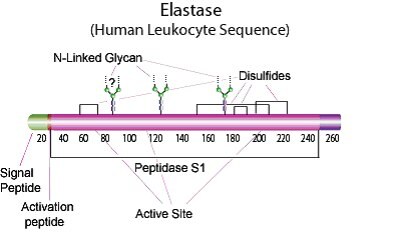Elastase Function and Importance
On this page:
- Physical Properties
- Clinical Implications
- Specificity, Kinetics and Activity Determination
- Storage and Stability
- Related Products
Enzyme Commission (EC) Number: 3.4.21.37
Product Number: E8140
Synonyms:
lysosomal elastase, neutrophil elastase, polymorphonuclear leukocyte elastase, serine elastase, lysosomal elastase, granulocyte elastase
Physical Properties
Leukocyte elastase is a 29KDa serine endoprotease of the Proteinase S1 Family. It exists as a single 238 amino acid-peptide chain with four disulfide bonds. The human leukocyte enzyme shares approximately 43% sequence homology with porcine pancreatic elastase. It contains two or thee N-linked glycans of variable composition which account for its three major isoforms.1,2,3
Isoelectric point: pI = 8.77 - 9.553

Clinical Implications
Elastase is one of the degradative hydrolases contained in the azurophil granules of phygocytic neutrophils.3
Elevated levels of circulating elastase and/or decreased levels of endogenous inhibitors have been implicated in several inflammatory diseases including arthritis,4 Cyclic neutropenia,5 Myocardial Ischemia,6 Pancreatitis,7 Psoriasis,8 Pulmonary Emphysema,9 and endotoxic shock.10
Several inhibitors of leukocyte elastase, including elafin, and have been proposed for treatment of related diseases.
Specificity, Kinetics and Activity Determination
Unlike pancreatic elastase the leukocyte enzyme has a preferential cleavage for the carboxyl side of valine, but will also cleave to a lesser extent after alanine.11,12,13 Natural substrates include elastin,14 cartilage proteoglycans,15 collagen types I, II, II and IV16,17,18 and fibronectin.19
pH Optimum for activity: 8.520
Sigma’s Unit Definition: One unit will release one nanomole of p-nitrophenol per second from N-t-BOC-L-alanine p-nitrophenyl ester at pH 6.5 at 37 °C

Method: Continuous Spectrophotometric Rate Determination
In a 3.00 mL reaction mix, the final concentrations are 49 mM sodium phosphate, 0.20 mM N-t-BOC-L-alanine p-nitrophenyl ester, 2% (v/v) acetonitrile, and 1 unit of elastase.
Storage and Stability Detergents such as 0.05-0.2%Triton® X-100 or 0.1% Brij® 35 are often included in reaction and extraction buffers to insure solubilization and reduce adhesion to glass particularly at low ionic strength.2,21
The enzyme retains activity after exposure to 8 M urea and retains 22% of its activity in the presence of 1% SDS. In SDS and 2-mercaptoethanol the enzyme undergoes autolysis giving rise to several low molecular weight fragments.22
Store lyophilized powder at -20 °C
Once reconstituted, store in frozen aliquots at or below -20 °C
Inhibitors
Synthetic Substrates
Elastin Derived Substrates
References
To continue reading please sign in or create an account.
Don't Have An Account?